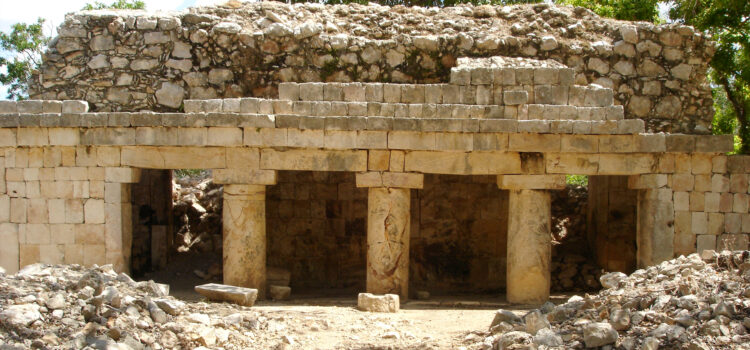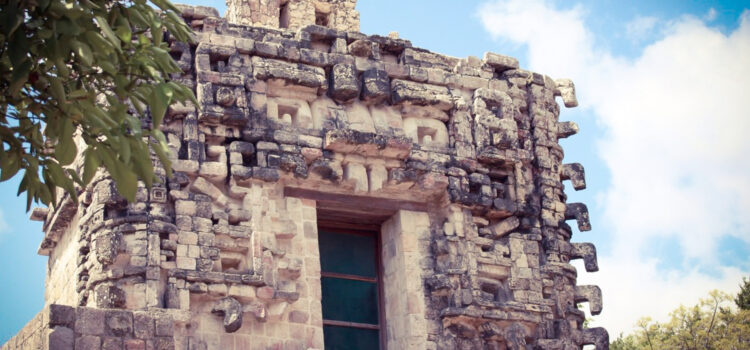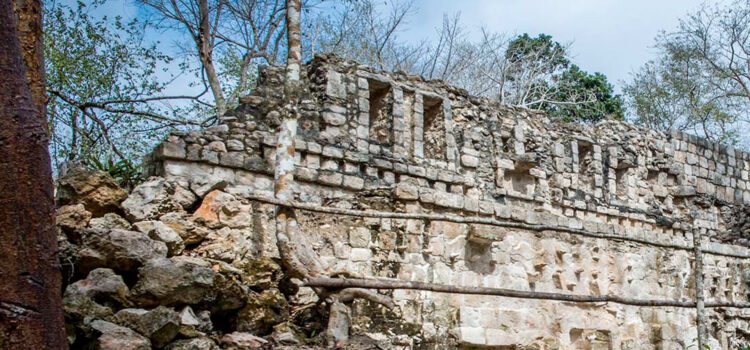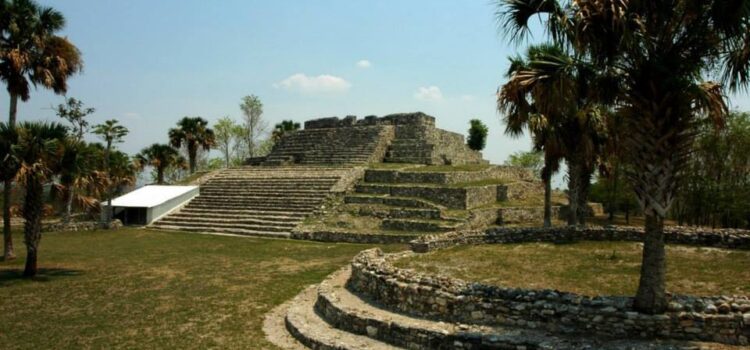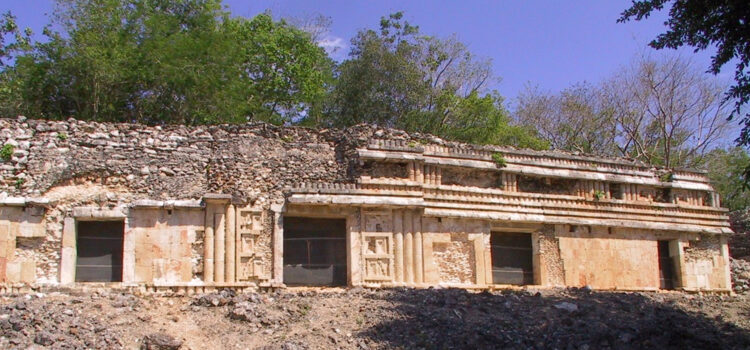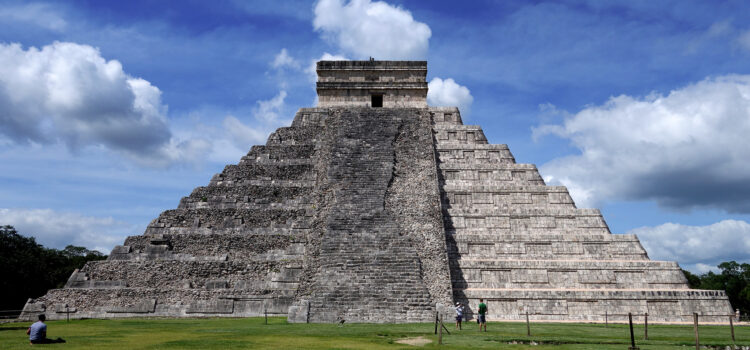Zona arqueológica Chicanná
This old pre-Hispanic settlement is one of the 16 currently open to the public of the State of Campeche. Its oldest occupation is located near the beginning of our era during the late preclassic period (300 BC to 250 AD), although its peak dates from the late classic (550 to 700 AD) when carried out Its last monumental constructions
If you would like to know everything about Chicanná and its relationship with Calakmul and the other archaeological zones we recommend you hire the service of a specialized guide on the subject.
- Chicanná is located at kilometer 141 of Federal Highway No. 186, Escárcega-Chetumal, 2 kilometers from the highway.
- Sundays are free for the national and residents with official identification.
- Cost of entry: 47 MXN.
- They do not sell drinks or food inside. There are services at the entrance.
- How to get there by public transport? To Xpuhil there is public transportation from Escárcega (2 hours), Chetumal (1 hour 40 minutes) and Campeche (4 hours 30 minutes).
- It is recommended to wear light and light clothes, hat, insect repellent, sunscreen, closed shoes better and some water is always going well.
Zona arqueológica Xcalumkín
The pre-Columbian vestiges of Xcalumkin cover an area of 10 km ² And they are important by the monumental architecture And by the great amount of hieroglyphic inscriptions associated. In some texts of the site the glyph emblem of jaina has been registered, Coastal city that distutes about 50 km And with which Xcalumkin maintained close relation, Especially in century VIII.
If you would like to know everything about Xcalumkín we recommend to hire the service of a specialized guide in the subject.
- Sundays are free for the national and residents with official identification.
- Cost of entry: 47 MXN.
- They do not sell drinks or food inside.
- It is recommended to wear light and light clothes, hat, insect repellent, sunscreen, closed shoes better and some water is always going well.
Zona arqueológica el Tabasqueño
The northeast sector of Campeche is characterized by the development of 1 distinctive architecture called chenes the monumental buildings of Tabasqueño belong to make revision, in which the façades of the temples are heavily loaded with symbolic motifs. There is close relationship with the properties of the river Bec region in southern Campeche and Quintana Roo, but it is still debated whether they are two sister traditions or one with occupied the center of the Yucatecan peninsula.
If you would like to know everything about Tabasqueño we recommend hiring the service of a specialized guide on the subject.
- Sundays are free for the national and residents with official identification.
- Cost of entry: 47 MXN.
- They do not sell drinks or food inside.
- It is recommended to wear light and light clothes, hat, insect repellent, sunscreen, closed shoes better and some water is always going well.
Tohcok
The prehispanic vestiges of Tohcok that today only cover a part of the original settlement that should have extended in average of 2 km², today can be visited in two buildings that conform a wide square, the constructions combine traits of architecture Chenes And of architecture Puuc, which Tells us about the fusion of construction systems between northeastern Campeche and the southern sectors of the Yucatan and the campechano northwest.
If you would like to know everything about Tohcok we recommend to hire the service of a specialized guide in the subject.
- Sundays are free for the national and residents with official identification.
- Cost of entry: 47 MXN.
- They do not sell drinks or food inside.
- It is recommended to wear light and light clothes, hat, insect repellent, sunscreen, closed shoes better and some water is always going well.
Kankí
Its pre-Columbian vestiges occupy an average surface of 10 km ² And they are important not only by the monumental architecture, but also because they can distinguish the sequence of development of several phases of the architecture Puuc especially between the years 500 and 700 of our era.
If you would like to know everything about Kankí we recommend to hire the service of a specialized guide in the subject.
- Sundays are free for the national and residents with official identification.
- Cost of entry: 47 MXN.
- They do not sell drinks or food inside.
- It is recommended to wear light and light clothes, hat, insect repellent, sunscreen, closed shoes better and some water is always going well.
Zona arqueológica El tigre
The archaeological zone takes its name from the adjacent ejido, in fact the tigers are of the old world but popularly it is called to empty Jaguar. In ancient times it was called itzamkanac “Seat of the lizard / snake” possibly alluding to the seat of the deity itzamna
The monumentality of the constructions And the extension of the zone indicate that it was the capital of the acalanes And perhaps the place where Hernán Cortés killed Cuauhtémoc.
It sits on a hill next to the Candelaria river. It has a long occupation sequence ranging from the preclassic middle 600 to 300 a. C. Until the protohistórico 1557 d. C. is conformed by six architectonic groups; The central aria includes peteneros buildings in the sub structures. Also elements of architecture Bec Bec And others of late times.
If you would like to know everything about The Tiger we recommend you hire the service of a guide specialized in the subject.
- Sundays are free for the national and residents with official identification.
- Cost of entry: 47 MXN.
- They do not sell drinks or food inside.
- It is recommended to wear light and light clothes, hat, insect repellent, sunscreen, closed shoes better and some water is always going well.
Hochob
It was one of the most important Mayan settlements of the Chenes region. And from the year 300 AD, its first settlers sat on a hill, where later they would build residences, more important public religious buildings. The slopes of Cerro were conditioned with terraces and platforms with dwelling houses of perishable materials. Several Aljibes or chultunes were built on the ground for the storage, storage and distribution of rainwater.
Hochob could depend on Dzibilnocac podés Santa Rosa Xtampac that had already acquired regional importance in the classic period. Its buildings were constructed between the years 600 to 900 d. C. But the greatest splendor was between 850 and 1000 AD. And today it retains buildings with large frontal masks and towers that characterize the Chenes region.
If you would like to know everything about Hochob we recommend hiring the service of a guide specialized in the subject.
- Sundays are free for the national and residents with official identification.
- They do not sell drinks or food inside.
- It is recommended to wear light and light clothes, hat, insect repellent, sunscreen, closed shoes better and some water is always going well.
Chunhuhub
In the mid-nineteenth century the explorers first reported the site as the stranger also some of its buildings. Later, in 1887 they visited the place and obtained the first architectural and photographic records. During the 30’s of last century, they documented the archaeological zone and several of their sculptures, which had been reused on facades of the houses of Xculoc. The first works of consolidation and restructuring were undertaken in the 80’s of the last century.
If you would like to know everything about Chunhuhub we recommend hiring the service of a specialized guide on the subject.
- Sundays are free for the national and residents with official identification.
- They do not sell drinks or food inside.
- It is recommended to wear light and light clothes, hat, insect repellent, sunscreen, closed shoes better and some water is always going well.
Rio Bec
Its name means “Rio del Robles”, and is located in the Calakmul Biosphere Reserve. The first building of the area was discovered between the years 1906 and 1907 by the French explorer Maurice de Périgny. This late and disembedded settlement gives name to the Rio Bec Region.
The site is composed of numerous groups with monumental buildings and it is believed that, due to its architecture and decoration, this place was controlled by the noble houses.
Rio Bec and a large part of the nearby settlements deviate from what may be considered the site model of the Maya Classic.
If you would like to know everything about Rio Bec we recommend hiring the service of a guide specialized in the subject.
- Access is in jungle road and a 4X4 pickup truck or a special transport service is required.
Chichén Itzá
The ancient city of Chichen Itza is the tourist jewel of the Yucatan Peninsula. Its colossal Pyramid of Kukulcan is considered as one of the 7 Wonders of the Modern World. Chichen is one of the places that one does not want to miss.
- Chichen Itza is located 120 km from the city of Mérida, 50 from Valladolid and 188 from Cancún. Located near one of the exits of highway 180 of payment or quota, that unites Merida-Cancún.
- Sundays are free for the national and residents with official identification. You must pay the additional payment of Cultur.
- Cost of entry: 59 MXN payment of the INAH, plus the payment of Cultur is 78 MXN for Mexicans and residents and 146 MXN for foreigners. Light and sound show is paid separately: 193 MXN
- They sell drinks and food inside the premises. There are services at the entrance and inside.
- How to get there by public transport? From Mérida CAME buses leave from calle 70 with 71, you have 1 hour 30 minutes “(schedules 6:15, 9:15 and 12:40 hrs) From Cancún, an ADO bus leaves at 8:45 am (Tulum Ave. Av. Uxmal), who returns from there at 16:30. 3 hours drive.
- Chichen Itza offers a light and sound show: at 20 in summer-autumn and at 19 in winter-spring.
- It is recommended to wear light and light clothing, hat, insect repellent, sunscreen, closed shoes and some water if you do not want to pay gold price there.

